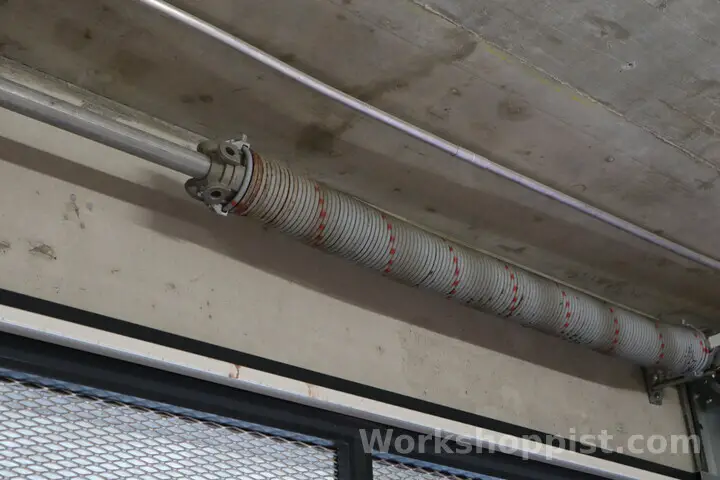This post tells you how much pretension garage door torsion springs need in standard configuration; i.e. how many turns should you wind to them.
Below, you find a table indicating the appropriate turns for each door height. Instructions for tuning and troubleshooting are included further down.
Before tensioning, make sure you have the correct spring size. See my Torsion Spring Sizing Chart or Spring Calculator for reference.

Garage Door Spring Tension Chart
The table below tells you the nominal tensioning for garage door torsion springs in turns for each door height. It also includes the same turn number in quarter-turns – this is the practical tensioning unit.
| TORSION SPRING TENSION DOOR HEIGHT | (4 in. drum) TURNS | QUARTER TURNS |
|---|---|---|
| 7 ft. | 7½ ±½ turns | 30±2 q. turns |
| 7½ ft. | 8 ±½ turns | 32±2 q. turns |
| 8 ft. | 8½ ±½ turns | 34±2 q. turns |
| 8½ ft. | 9 ±½ turns | 36±2 q. turns |
| 9 ft. | 9½ ±½ turns | 38±2 q. turns |
| 9½ ft. | 10 ±½ turns | 40±2 q. turns |
| 10 ft. | 10½ ±½ turns | 42±2 q. turns |
| 10½ ft. | 11 ±½ turns | 44±2 q. turns |
| 11 ft. | 11½ ±½ turns | 46±2 q. turns |
NB. Doors of the same height take the same number of turns for the springs. Springs on both 9×7 ft. and 16×7 ft. doors should be wound to 7½ turns of tension – the width does not matter.
How to adjust spring tension?
Garage door springs are first wound to the nominal tension. The tension is then fine-tuned to have the door open and close easily. You may want to disconnect the door opener arm to avoid it interfering with the tuning.
1 TENSION. Wind the springs to the nominal tension indicated in the table. This is very close to the right tension.
2 TEST. Carefully try to operate the door. Check that the door …
- Stays in the fully closed position
- Is light to lift
- Stays in the fully open position
- Is light to pull down
3 FINE-TUNE. Make small changes to tension with these rules:
- Door was heavy to lift -> Increase tension
- Door did not open fully -> Increase tension
- Door did not close fully -> Decrease tension
- Door was heavy to pull down -> Decrease tension
NB. Adjust tension only by ½ turn (2 quarters) either way. Going looser risks cable lifting off the drum; going tighter risks premature spring failure.
How to tell if the spring tension is too high?
Garage door torsion spring tension may be too high if the door does not stay closed or is heavy to pull down.
Also note that the door spring tension is always too high if the turns exceed the range in the table above (e.g. 8 turns for a 7 ft. door) – this is regardless of how the door works. A spring with too many turns is overloaded and will fail fast.
How to tell if the spring tension is too low?
Garage door spring tension may be too low if the door is heavy to lift or will not fully open without force.
The tension is always too low if the turns are lower than the range indicated in the table (e.g. 7 turns for a 7 ft. door).
How to tell if the spring size is wrong?
If you must go more than one full turn looser or tighter than the nominal tension indicated in the table, the spring size is probably wrong for the door. Please check my Torsion Spring Sizing Chart.
The spring size is probably also wrong if you get conflicting advice for fine-tuning.
A spring that’s too stiff cannot be tensioned so that the door stays close and goes easily fully open – you can only get one or the other. Put another way, a stiff spring helps too much in the start and too little in the end.
A spring that is too flexible makes the door heavy to lift or difficult to pull down. Such a spring changes its lift over the travel less than it should.